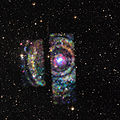English: Astronomers using NASA's Chandra X-ray Observatory have discovered the largest and brightest set of rings from X-ray light echoes ever observed. These extraordinary rings, produced by an intense flare from a neutron star, providing astronomers a rare chance to determine how far it is from Earth.
The rings appear as circles around Circinus X-1, a double star system in the plane of the Milky Way containing a neutron star, the dense remnant of a massive star pulverized in a supernova explosion. The neutron star is in orbit with another massive star, and is shrouded by thick clouds of interstellar gas and dust. Circinus X-1 is also the source of a surprisingly powerful jet of high-energy particles.
"It's really hard to get accurate distance measurements in astronomy and we only have a handful of methods,” said Sebastian Heinz of the University of Wisconsin in Madison, who led the study. “But just as bats use sonar to triangulate their location, we can use the X-rays from Circinus X-1 to figure out exactly where it is."
The light echo shows that Circinus X-1 is located about 30,700 light years from Earth, and settles the difference in results published in prior studies. The detection and characterization of the rings required the unique capabilities of Chandra -- the ability to detect fine details combined with sensitivity to faint signals.
Researchers determined that the rings are echoes from a burst of X-rays emitted by Circinus X-1 in late 2013. The burst reflected off intervening clouds of dust, with some reflected X-rays arriving to Earth from different angles at a time delay of about one to three months, creating the observed rings.
By comparing the Chandra data to prior images of dust clouds detected by the Mopra radio telescope in Australia, the researchers determined that each ring was created by the X-ray reflections off a different dust cloud. The radio data provides the distance to the different clouds and the X-ray echo determines the location of Circinus X-1 relative to the clouds. An analysis of the rings with the combined radio data allows researchers to use simple geometry to accurately determine the distance of Circinus X-1 from Earth.
"We like to call this system the 'Lord of the Rings,' but this one has nothing to do with Sauron," said co-author Michael Burton of the University of New South Wales in Sydney, Australia. "The beautiful match between the Chandra X-ray rings and the Mopra radio images of the different clouds is really a first in astronomy."
This new distance estimate means that Circinus X-1 is inherently much brighter in X-rays and other types of light than some scientists previously thought, and indicates that the star system has repeatedly passed a key threshold for brightness where the outward pressure from radiation by the system is balanced by the inward pull of gravity. This behavior is something astronomers generally see more often in systems containing black holes than in systems like Circinus X-1 that contain a neutron star.
The researchers also determined that the speed of the jet of high-energy particles produced by the system is at least 99.9% of the speed of light. This extreme velocity is usually associated with jets produced by a black hole.
"Circinus X-1 acts in some ways like a neutron star and in some like a black hole," said co-author Catherine Braiding, also of the University of New South Wales. "It's extremely unusual to find an object that has such a blend of these properties."
Circinus X-1 is thought to have originally become an X-ray source about 2,500 years ago, as seen from Earth. This makes Circinus X-1 the youngest so-called X-ray binary known. The new Chandra data allows astronomers to make a detailed three-dimensional map of the dust clouds between Circinus X-1 and us, providing a valuable probe of the structure of the galaxy.
These results have been published on June 23 in The Astrophysical Journal and are available online. NASA's Marshall Space Flight Center in Huntsville, Alabama, manages the Chandra program for the agency's Science Mission Directorate in Washington. The Smithsonian Astrophysical Observatory in Cambridge, Massachusetts, controls Chandra's science and flight operations.






